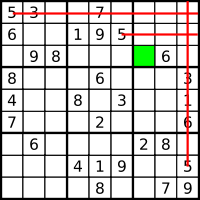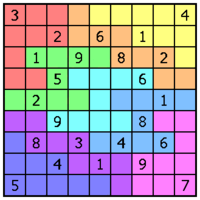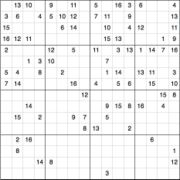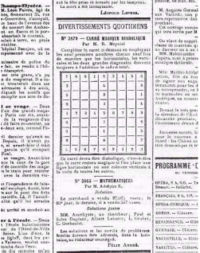Sudoku
2007 Schools Wikipedia Selection. Related subjects: Recreation
Sudoku (数独 sūdoku ?), also known as Number Place or Nanpure, is a logic-based placement puzzle. The objective is to fill the grid so that every column, every row and every 3×3 box contains the digits 1 to 9. The puzzle setter provides a partially completed grid so that there is only one solution.
Completed Sudoku puzzles are a type of Latin square, with an additional constraint on the contents of individual regions. Leonhard Euler is sometimes (incorrectly) cited as the source of the puzzle, based on his work with Latin squares.
The modern puzzle was invented by an American, Howard Garns, in 1979 and published by Dell Magazines under the name "Number Place". It became popular in Japan in 1986, when it was published by Nikoli and given the name Sudoku. It became an international hit in 2005.
Introduction
The name "Sudoku" is the Japanese abbreviation of a longer phrase, "Sūji wa dokushin ni kagiru" (数字は独身に限る ?), meaning "the digits must occur only once". It is a trademark of puzzle publisher Nikoli Co. Ltd. in Japan. In Japanese, the word is pronounced [sɯːdokɯ]; in English, it is usually spoken with an Anglicised pronunciation, [səˈdəʊkuː] (BrE) [səˈdoʊkuː] (AmE) or [ˈsuːdəʊku] (BrE) [ˈsuːdoʊku] (AmE) (See IPA (International Phonetic Alphabet) or IPA chart for English for notation usage.) Other Japanese publishers refer to the puzzle as Number Place, the original U.S. title, or as "Nanpure" for short. Some non-Japanese publishers spell the title as "Su Doku".
The numerals in Sudoku puzzles are used for convenience; arithmetic relationships between numerals are irrelevant. Any set of distinct symbols will do; letters, shapes, or colours may be used without altering the rules. In fact, ESPN published Sudoku puzzles substituting the positions on a baseball field for the numbers 1–9. Dell Magazines, the puzzle's originator, has been using numerals for Number Place in its magazines since they first published it in 1979.
The attraction of the puzzle is that the rules are simple, yet the line of reasoning required to solve the puzzle may be complex. The level of difficulty can be selected to suit the audience. The puzzles are often available free from published sources and may be custom-made using software.
Solution methods
The strategy for solving a puzzle may be regarded as comprising a combination of three processes: scanning, marking up, and analyzing.
Scanning
Scanning is performed at the outset and throughout the solution. Scans need to be performed only once in between analyses. Scanning consists of two techniques:
- Cross-hatching: the scanning of rows to identify which line in a region may contain a certain numeral by a process of elimination. The process is repeated with the columns. For fastest results, the numerals are scanned in order of their frequency, from high to low. It is important to perform this process systematically, checking all of the digits 1–9.
- Counting 1–9 in regions, rows, and columns to identify missing numerals. Counting based upon the last numeral discovered may speed up the search. It also can be the case, particularly in tougher puzzles, that the best way to ascertain the value of a cell is to count in reverse—that is, by scanning the cell's region, row, and column for values it cannot be, in order to see what remains.
Advanced solvers look for "contingencies" while scanning, narrowing a numeral's location within a row, column, or region to two or three cells. When those cells lie within the same row and region, they can be used for elimination during cross-hatching and counting. Puzzles solved by scanning alone without requiring the detection of contingencies are classified as "easy"; more difficult puzzles cannot be solved by basic scanning alone.
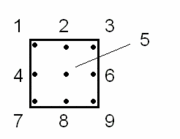
Marking up
Scanning stops when no further numerals can be discovered, making it necessary to engage in logical analysis. One method to guide the analysis is to mark candidate numerals in the blank cells. There are two popular notations: subscripts and dots.
- In the subscript notation the candidate numerals are written in subscript in the cells. Because puzzles printed in a newspaper are too small to accommodate more than a few subscript digits of normal handwriting, solvers may create a larger copy of the puzzle.
- The second notation uses a pattern of dots in each square, where the dot position indicates a number from 1 to 9. The dot notation can be used on the original puzzle. Dexterity is required in placing the dots, since misplaced dots or inadvertent marks inevitably lead to confusion and may not be easily erased.
An alternative technique is to "mark up" the numerals that a cell cannot be. A cell will start empty and as more constraints become known, it will slowly fill until only one mark is missing. Assuming no mistakes are made and the marks can be overwritten with the value of a cell, there is no longer a need for any erasures.
Analysis
The two main approaches to analysis are "candidate elimination" and "what-if". In "candidate elimination", progress is made by successively eliminating candidate numerals from cells to leave one choice. After each answer has been achieved, another scan may be performed—usually checking to see the effect of the contingencies. In general, if entering a particular numeral prevents completion of the other necessary placements, then the numeral in question can be eliminated as a candidate. One method works by identifying "matched cell groups". For instance, if precisely two cells within a scope (a particular row, column, or region) contain the same two candidate numerals (p,q), or if precisely three cells within a scope contain the same three candidate numerals (p,q,r), these cells are said to be matched. The placement of those candidate numerals anywhere else within that same scope would make a solution impossible; therefore, those candidate numerals can be deleted from all other cells in the scope.
In the "what-if" approach (also called "guess-and-check", "bifurcation", " backtracking" and " Ariadne's thread"), a cell with two candidate numerals is selected, and a guess is made. The steps are repeated unless a duplication is found or a cell is left without a possible candidate, in which case the alternative candidate must be the solution. For each cell's candidate, the question is posed: 'will entering a particular numeral prevent completion of the other placements of that numeral?' If the answer is 'yes', then that candidate can be eliminated. The what-if approach requires a pencil and eraser or a good layout memory.
There are three kind of conflicts, which can appear during puzzle solving:
- basic conflicts - there are only N-1 different candidates in N cell in the area
- fish conflicts - when eliminating number from N rows/columns, it will disappear also from N+1 columns/rows.
- unique conflicts - this pattern means multiple solutions, all numbers in the pattern exist exactly two times in every area, row and column. If there are only one candidate in the cell, any virtual candidate can be added.
Encountering any of those would indicate that the puzzle is not uniquely solvable. So, if you encounter them as a consequence of "what-if", you use your eraser and go back to try untried alternatives.
Computer solutions
There are two general approaches taken in the creation of serious Sudoku-solving programs: human solving methods and rapid-style methods. Human-style solvers will typically operate by maintaining a mark-up matrix, and search for contingencies, matched cells, and other elements that a human solver can utilize in order to determine and exclude cell values.
Many rapid-style solvers employ backtracking searches, with various pruning techniques also being used in order to help reduce the size of the search tree.
Rapid solvers are preferred for trial-and-error puzzle-creation algorithms, which allow for testing large numbers of partial problems for validity in a short time; human-style solvers can be employed by hand-crafting puzzlesmiths for their ability to rate the challenge of a created puzzle and show the actual solving process their target audience can be expected to follow.
Although vanilla Sudoku puzzles (with 9×9 grid and 3×3 regions) can be solved quickly by computer, the generalization to larger grids is known to be NP-Complete. Various optimisation methods have been proposed for large grids.
Difficulty ratings
The difficulty of a puzzle is based on the relevance and the positioning of the given numbers rather than their quantity. Surprisingly, the number of givens does not always reflect a puzzle's difficulty. Computer solvers can estimate the difficulty for a human to find the solution, based on the complexity of the solving techniques required. Some online versions offer several difficulty levels.
Most publications sort their Sudoku puzzles into four or five rating levels, although the actual cut-off points and the names of the levels themselves can vary widely. Typically, however, the titles are synonyms of "easy", "intermediate", "hard", and "challenging". An easy puzzle can be solved using only scanning; an intermediate puzzle may take markup to solve; a hard or challenging puzzle will usually take analysis.
Another approach is to rely on the experience of a group of human test solvers. Puzzles can be published with a median solving time rather than an algorithmically defined difficulty level.
Construction
Building a Sudoku puzzle can be performed by pre-determining the locations of the givens and assigning them values only as needed to make deductive progress. This technique gives the constructor greater control over the flow of puzzle solving, leading the solver along the same path the compiler used in building the puzzle. Great caution is required, however, as failing to recognize where a number can be logically deduced at any point in construction—regardless of how tortuous that logic may be—can result in an unsolvable puzzle when defining a future given contradicts what has already been built. Building a Sudoku with symmetrical givens is a simple matter of placing the undefined givens in a symmetrical pattern to begin with.
Nikoli Sudoku are hand-constructed, with the author being credited; the givens are always found in a symmetrical pattern. Dell Number Place Challenger (see Variants below) puzzles also list authors. The Sudoku puzzles printed in most UK newspapers are apparently computer-generated but employ symmetrical givens; The Guardian famously claimed that because they were hand-constructed, their puzzles would contain "imperceptible witticisms" that would be very unlikely in computer-generated Sudoku.
Variants
Even though the 9×9 grid with 3×3 regions is by far the most common, variations abound: sample puzzles can be 4×4 grids with 2×2 regions; 5×5 grids with pentomino regions have been published under the name Logi-5; the World Puzzle Championship has previously featured a 6×6 grid with 2×3 regions and a 7×7 grid with six heptomino regions and a disjoint region. Larger grids are also possible, with Daily SuDoku's 16×16-grid Monster SuDoku , the Times likewise offers a 12×12-grid Dodeka sudoku with 12 regions each being 4×3, Dell regularly publishing 16×16 Number Place Challenger puzzles (the 16×16 variant often uses 1 through G rather than the 0 through F used in hexadecimal), and Nikoli proffering 25×25 Sudoku the Giant behemoths. Even larger sizes, for instance 100×100, have been claimed.
Another common variant is for additional restrictions to be enforced on the placement of numbers beyond the usual row, column, and region requirements. Often the restriction takes the form of an extra "dimension"; the most common is for the numbers in the main diagonals of the grid to also be required to be unique. The aforementioned Number Place Challenger puzzles are all of this variant, as are the Sudoku X puzzles in the Daily Mail, which use 6×6 grids.
Puzzles constructed from multiple Sudoku grids are common. Five 9×9 grids which overlap at the corner regions in the shape of a quincunx is known in Japan as Gattai 5 (five merged) Sudoku. In The Times, The Age and The Sydney Morning Herald this form of puzzle is known as Samurai SuDoku. Puzzles with twenty or more overlapping grids are not uncommon in some Japanese publications. Often, no givens are to be found in overlapping regions. Sequential grids, as opposed to overlapping, are also published, with values in specific locations in grids needing to be transferred to others.
Alphabetical variations have also emerged; there is no functional difference in the puzzle unless the letters spell something. Some variants, such as in the TV Guide, include a word reading along a main diagonal, row, or column once solved; determining the word in advance can be viewed as a solving aid. The Code Doku devised by Steve Schaefer has an entire sentence embedded into the puzzle; the Super Wordoku from Top Notch embeds two 9-letter words, one on each diagonal. It is debatable whether these are true Sudoku puzzles: although they purportedly have a single linguistically valid solution, they cannot necessarily be solved entirely by logic, requiring the solver to determine the embedded words. Top Notch claims this as a feature designed to defeat solving programs.
Here are some of the more notable single-instance variations:
- A three-dimensional Sudoku puzzle was invented by Dion Church and published in the Daily Telegraph in May 2005.
- The 2005 U.S. Puzzle Championship includes a variant called Digital Number Place: rather than givens, most cells contain a partial given—a segment of a number, with the numbers drawn as if part of a seven-segment display.
- The online journal Speculative Grammarian has published a trio of linguistics-themed Sudoku-like puzzles called LingDoku, which require the solver to solve for two or more variables at once, including a simple 3×3 puzzle,, a slightly more complicated 4x4 puzzle, and a Samurai-style puzzle with 3 overlapping 3×3 grids.
A new variant without any given numbers for start comes up this summer (2006) from India by Yoogi Games, named Greater-Than or Comparison Sudoku. All rules of a standard Sudoku are the same, but you have to find out by comparisons the sequence of the digits (or letters if you want, but the symbols used must be in ascending order) from one through nine for each region. Therefore, each cell's border line inside every region is notched in the meaning of < (less than) – or vice versa. A 3D variant of Sudoku is Sudoku-Ball™,. Sudoku-Ball contains 14 networked sudokus that follow the idea of the 2D samurai puzzle but than converted into 3D. The physical game is not yet available on the market but is due to release early 2007.
A Hexudoku is a variant of the game Sudoku, which uses a grid of 16x16 squares instead of 9x9. The name originates from the contraction of the greek-, and latin prefixes hexa-deca, which means 16, and the word sudoku.
Similar to sudoku, the goal of the game is to complete a not-completely filled grid, such that each row, each column, and each of the 16 marked 4x4 squares contains each number between 1 and 16 exactly once. With 256 squares, the hexudoku has more than 3 times as many squares as the regular sudoku.
Instead of the numbers 1 to 16, sometimes the hexadecimal digits 0-9, a-f are used, or a variant starting at 1: 1-9, a-g. Also a letter-only variant is sometimes used.
Mathematics of Sudoku
A completed Sudoku grid is a special type of Latin square with the additional property of no repeated values in any 3×3 block. The number of classic 9×9 Sudoku solution grids was shown in 2005 by Bertram Felgenhauer and Frazer Jarvis to be 6,670,903,752,021,072,936,960 (sequence A107739 in OEIS) : this is roughly 0.00012% the number of 9×9 Latin squares. Various other grid sizes have also been enumerated—see the main article for details. The number of essentially different solutions, when symmetries such as rotation, reflection and relabelling are taken into account, was shown by Ed Russell and Frazer Jarvis to be just 5,472,730,538 (sequence A109741 in OEIS). Both results have been confirmed by independent authors.
The maximum number of givens provided while still not rendering the solution unique is four short of a full grid; if two instances of two numbers each are missing and the cells they are to occupy form the corners of an orthogonal rectangle, and exactly two of these cells are within one region, there are two ways the numbers can be assigned. Since this applies to Latin squares in general, most variants of Sudoku have the same maximum. The inverse problem—the fewest givens that render a solution unique—is unsolved, although the lowest number yet found for the standard variation without a symmetry constraint is 17, a number of which have been found by Japanese puzzle enthusiasts, and 18 with the givens in rotationally symmetric cells.
History
Number puzzles first appeared in newspapers in the late 19th century, when French puzzle setters began experimenting with removing numbers from magic squares. Le Siècle, a Paris-based daily, published a partially completed 9×9 magic square with 3×3 sub-squares in 1892. It was not a Sudoku because it contained double-digit numbers and required arithmetic rather than logic to solve, but it shared key characteristics: each row, column and sub-square added up to the same number.
Within three years Le Siècle's rival, La France, refined the puzzle so that it was almost a modern Sudoku. It simplified the 9×9 magic square puzzle so that each row and column contained only the numbers 1–9, but did not mark the sub-squares. Although they are unmarked, each 3×3 sub-square does indeed comprise the numbers 1–9. However, the puzzle cannot be considered the first Sudoku because, under modern rules, it has two solutions. The puzzle setter ensured a unique solution by requiring 1–9 to appear in both diagonals.
These weekly puzzles were a feature of newspaper titles including L'Echo de Paris for about a decade but disappeared about the time of the First World War.
According to Will Shortz, the modern Sudoku was most likely designed anonymously by Howard Garns, a 74-year-old retired architect and freelance puzzle constructor, and first published in 1979 by Dell Magazines as Number Place (the earliest known examples of modern Sudoku), because Garns' name was always present on the list of contributors in issues of Dell Pencil Puzzles and Word Games that included Number Place, and was always absent from issues that did not. Sadly, he died in 1989 before getting a chance to see his creation as a worldwide phenomenon.
The puzzle was introduced in Japan by Nikoli in the paper Monthly Nikolist in April 1984 as Suuji wa dokushin ni kagiru (数字は独身に限る ?), which can be translated as "the numbers must be single" or "the numbers must occur only once." At a later date, the name was abbreviated to Sudoku by Maki Kaji (鍜治 真起 Kaji Maki ?), taking only the first kanji of compound words to form a shorter version. In 1986, Nikoli introduced two innovations: the number of givens was restricted to no more than 32, and puzzles became "symmetrical" (meaning the givens were distributed in rotationally symmetric cells). It is now published in mainstream Japanese periodicals, such as the Asahi Shimbun.
Competitions
- The first world championship was held in Lucca, Italy from 10 to 12 March 2006; it was won by Jana Tylová, a 31-year-old accountant from the Czech Republic. The competition included numerous variants.
- The second world championship will be held in Prague from March 28 to April 1, 2007;
Related games
- Minesweeper (computer game)
- Paint by numbers

